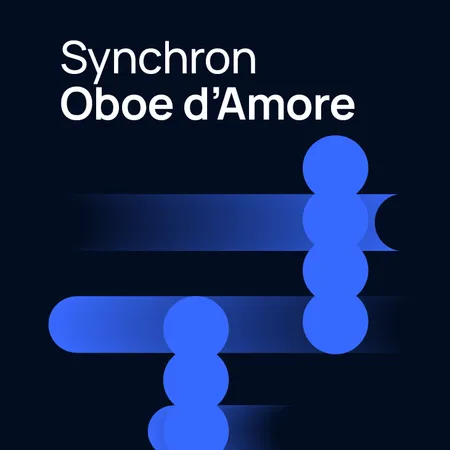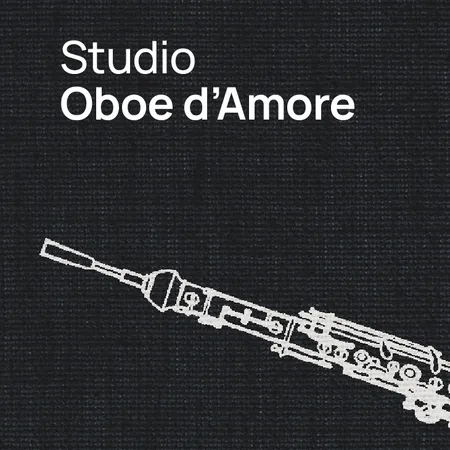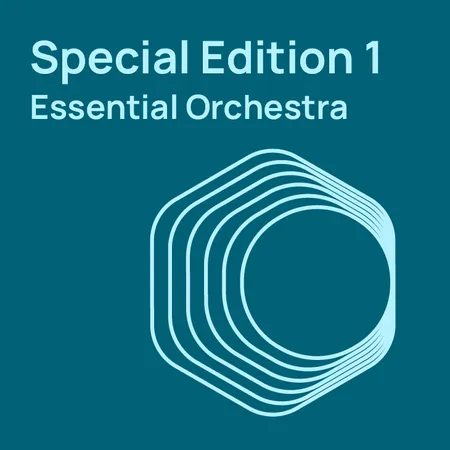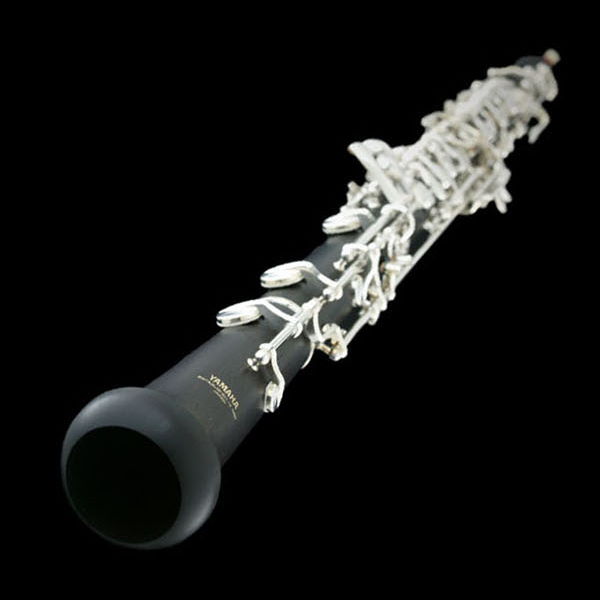
Name: Oboe
Spelling
German: Oboe
French: hautbois
Italian: oboe
Classification: Aerophone, double-reed instrument, woodwind instrument
Material: Wood (grenadilla, rosewood, ebony, cocobolo)
Mouthpiece: Double-reed mouthpiece: two reeds lying close together
Tubing: Length 62-75 cm (incl. mouthpiece), conical
Bore: Narrow, inner diameter (4,1 mm at its narrowest)
Keys: Conservatoire system (French system) or Viennese
Bell: flare-shaped
Tuning: In C
Discover our Oboes
The appearance of the two instruments differs in that the French oboe has a long, thin tube of plain design with a gently flaring bell whereas the Viennese oboe still possesses the characteristics of the classical oboe: the shorter, thick-walled tube; the baluster on the upper joint; the widening at the tenon joints and the bell-shaped bell.
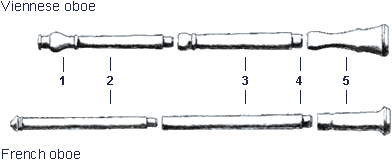
*1 test english; 2 upper joint; 3 lower joint; 4 tenon; 5 bell*
The French oboe has a narrow bore, 4.1 mm at its narrowest. The Viennese oboe's bore is wider (4.4-4.9 mm) and progresses in two steps. The Viennese model also has a contraction rim in the bell.
Viennese oboists use a special fingering from B5 to C6, the so-called “long fingerings”, i.e. the notes are produced with a long air column (many tone holes closed). On the French oboe the same notes are produced with the aid of a speaker key and “short fingerings”, i.e., a short air column.
The fully automatic Viennese oboe offers short fingerings as an alternative to the traditional long fingerings (the notes sound a little thinner).
The French oboe has a very assertive sound which can be heard distinctly in the orchestra, whereas the Viennese oboe tends to blend more with the overall sound. Vibrato, one of the desirable techniques on the French oboe, is not usual in the Viennese style.
The French oboe has a slower response in the lower register than the Viennese oboe. The sound of the French oboe from Bb5-C6 is found by many oboists to be slightly unsatisfactory.
Double-reed wind instruments have been used since antiquity; the earliest images depicting such instruments are from Mesopotamia from about 3,000 BC.
In the Greek and Roman civilizations double-reed instruments were the most highly regarded of all instruments. Playing the aulos or tibia was associated with high social standing and the musicians enjoyed great popularity and many privileges.
Portrayals of aulos players in Ancient Greece traditionally depict a musician blowing two instruments; this proves that the aulos was a double instrument. Different types of aulos were played on different occasions - as was the Roman tibia - for example on the battlefield, during the preparations for a banquet, at festivities and in the theater, where it accompanied the chorus.
It can no longer be ascertained for certain whether modern oboes are direct descendants of the Greek and Roman double-reed instruments or whether they were lost during the migration of peoples in Europe and returned there later by way of Byzantium and Asia.
In the Europe of the early middle ages, however, an instrument was in use that consisted of a single tube and was known as the calamus (calamus is the Latin word for reed). It is from this word that the English name shawm was derived (as was the German Schalmei and the French chalemie and chalumeau). The term shawm was not restricted to any one single instrument but described an instrument type which was played with a single or double reed.
The Renaissance shawm family included not only crumhorns, dolcians and bagpipes but also the bombarde or pommer groups, which are regarded as the direct precursors of modern double-reed instruments.
In keeping with Renaissance custom, the bombarde family consisted of instruments of every pitch, from the treble shawm (third octave above middle C) to the great bass shawm (contraoctave). The treble shawm was the oldest member of the bombarde family, and, like all bombardes, had a wind-cap which was taken into the mouth for blowing. The double-reed was inside this wind-cap and was not touched by the musician who consequently had no possibility of influencing the sound, which was relatively static.
Renaissance shawms were played mainly by itinerant minstrels, who did not specialize in any one instrument but could play several different ones.
During the 17th century the treble shawm evolved into the hoboy or hautboy (known in France as the hautbois), which was tuned to C. This early oboe no longer had a wind-cap and the musician's lips made direct contact with the double-reed, which meant he was able to inject more life into the instrument's sound. The tube, which was made of boxwood and on the shawm had been a single piece, now consisted of three parts, the upper and lower joints and the bell. In addition, three keys were added (although these were reduced to two a short time later). The bell was bordered by a contraction rim.
These innovations originated in France and were probably due in no small measure to the instrument-making families of Hotteterre (the name had been a byword for innovative instrument-making since the 16th century) and Philidor. Like all baroque woodwinds the hautboy's timbre differed throughout its range because intermediate notes which were played with cross-fingerings sounded more veiled.
In the late 17th century the hautboy was accepted into the orchestra. Jean Baptiste Lully, court composer to the "Sun King" Louis XIV presumably used it in his ballet L'Amour Malade in 1657. Robert Cambert included the instrument in his opera Pomone in 1671. From that point on the hautboy flourished, its heyday lasting until the end of the 18th century. During this period up to thirty hautboy players were engaged in the grande écurie, the French court orchestra.
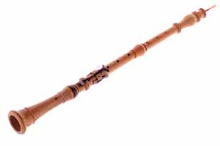
Oboe, Europe, Adi Schlinger, ca. 1730. Courtesy of Heinz Preiss (Musikinstrumentenmuseum Schloss Kremsegg, Austria, Sammlung Streitwieser)
Starting from France the hautboy rapidly gained great popularity all over Europe. Unlike the flute there were no particular national styles or schools of oboe playing initially; the musicians passed the latest playing techniques and instruments around among themselves. The baroque hautboy was a special case inasmuch as it was the only instrument to be used in every context, from military to chamber music to the opera, the orchestra and sacred music.
In the orchestra hautboys were initially used mainly to double the violins, although they had asserted themselves by the Classical period and were performing functions of their own. In the opera orchestra they were given their first solo roles (obligatos) in arias. The instrument's repertoire in chamber music originally consisted chiefly of pieces for consorts (two oboes, two tenor oboes [later replaced by horns] and two bassoons). At the beginning of the 18th century countless solo sonatas, suites with basso continuo, suites for trios (oboe, flute and violin) and concertos were produced. In the second half of the 18th century the oboe quartet (oboe with a string trio) emerged. At the same time the hautboy was gradually losing its place as the lead instrument in military ensembles to the clarinet.
In the 18th century the hautboy underwent continual improvements to its construction and sound. The bore was narrowed (from around an average of 5.9 mm to 4.8 mm), the reeds became narrower and shorter, the walls of the tube thinner and the tone holes smaller. A direct result of these measures was an increase in range: whereas the instrument's range was given as C4 to D6 at the turn of the 18th century it increased during the next hundred years to G6. The sound of the new classical hautboy was narrower and more focused than that of its predecessors and its volume corresponded to that of the violin or the flute.
The most renowned oboe makers of the time were Christophe Delusse and the duo Thomas Lot and Charles Bizey in France, David Denner, Wilhelm Oberländer and Carl Golde in Germany and Thomas Stanesby and Caleb Gedney in England. In the second half of the 18th century the instruments made by Augustin Grenser and Jakob Grundmann in Dresden became accepted as standard all over Europe.
In 1781 Grundmann added a third key to the oboe, and from that point on German instrument makers began adding more and more keys. The aim was to provide a tone hole which could be closed by a key for every half tone so that cross-fingerings would no longer be necessary. This trend was followed in France, albeit with some misgivings, since many musicians felt that the quality of the sound suffered from a surfeit of keys.
In around 1825 oboes with fifteen tone holes and ten keys were being made in both Germany and France. Despite this the instruments had a fundamental difference, since the differing sound esthetics governing oboe-making had led to the emergence of two distinct types which later became known as the “French” oboe and the “German” oboe.
In France the trend was toward narrower tubing, thinner walls and thinner reeds, whereas in Germany a wider bore was retained along with the characteristics of the classic oboe - thick-walled tubing, a contraction rim round the inside of the bell, the barrel (baluster) and rings on the upper joint with the simple mechanism featuring long-levered keys mounted on wooden blocks. Stephan Koch (1772-1828) and Joseph Sellner (1787-1843) developed an innovative version in 1820 in Vienna which combined features of both models: a classic appearance with a bore that was extremely narrow by the standards of the time.
Both the French oboe and the Viennese “Sellner-Koch oboe” had a bright sound and were distinctly audible in the orchestra, whereas the German oboe retained the darker timbre of the classical era which was more conducive to tonal blending.
In France, inventive instrument makers provided the oboe with a constant stream of technical innovations, among them the speaker key (which made overblowing unnecessary), a mechanism that made a complex interaction of levers and keys possible (introduced by the Triébert family), Theobald Boehm's ring key (operating a key by means of a ring on a rod; at the same time another tone hole is closed) and Auguste Buffet's pin springs.
Theobald Boehm (1794-1881), a trained goldsmith and flutist, developed a revolutionary keywork for the transverse flute which was received with great enthusiasm in France. Some parts of this system were subsequently adapted for use on the other woodwind instruments, although a radically altered Boehm oboe failed to gain acceptance on account of its novel sound (as did a Boehm bassoon).
From the 1860s onward the instrument maker Frédéric Triébert (1813-1878) developed oboes together with the oboist Apollon M. R. Barret (ca. 1804-1879) which are direct antecedents of today's instruments. Triébert's système 6 with its extremely narrow bore and speaker key was patented in 1872. Ten years later the oboe professor Georges Gillet pronounced it the official model at the Conservatoire de Paris. After the Second World War this conservatoire model, modified only slightly, became the international standard.
The Viennese oboe played in Austria today is a development on a model made in the 1840s by the instrument maker Carl Golde (1803-1873) in Dresden. Its body still has the classic form, with the flared bell, the barrel (baluster) on the upper joint and the widening at the tenon joints. The tubing is shorter and more conical than that of the French oboe. The keywork, which follows the pattern of the German mechanism, was improved and extended during the 20th century.
Although the oboe was used almost exclusively in the orchestra in the 19th century, 20th century composers rediscovered the instrument's potential as a solo instrument. This was due in no small measure to the outstanding oboists Leon Goossens (1897-1988), who established a number of techniques which facilitated playing (diaphragm breathing, relaxed embouchure) and Heinz Holliger (born 1939), who has propagated countless new playing techniques.
The oboe is notated in treble clef (non-transposing).
The oboe's range is from Bb3 - G6 (A6).
Lower register
- Viennese oboe: Bb3-A4
French oboe: Bb3-F4
Middle register
- Viennese oboe: Bb4-A5
French oboe: F#4-Bb5
Upper register
- Viennese oboe: Bb5-G6
French oboe: B5-G6
The double reed is placed between the lips and blown which causes both reeds to vibrate against each other. They open and close very rapidly, sending bursts of energy into the air column inside the instrument and causing it to vibrate in sympathy.
A good oboist is one who can do this in a controlled and sensitive way.
As on all woodwind instruments it is primarily the keys which are used to produce the various pitches. The oboe overblows to the octave. The speaker keys make overblowing largely redundant. Six of the tone holes are closed directly by the fingers, all the others by keys.
French oboe
- Bb3 - B4: normal attack (from the fundamental)
C5 - G#5: 1st speaker key is used
A5 - C6: 2nd speaker key used
C#6, D6 and D#6: overblowing to the 3rd partial (no speaker key).
E6 and above: 3rd speaker key used
Viennese oboe
- (Bb3) B3 - C5: normal attack (from the fundamental)
C#5, D5, D#5: overblowing to the 2nd partial (1st degree overblowing)
E5 - Bb5: 1st speaker key is used
B5 - D#6: overblowing to the 3rd partial (no speaker key).
E6 and above: 2nd speaker key used
On the Viennese oboe the notes Bb5, B5 and C6 are produced using the traditional “long fingerings”, i.e., many tone holes are closed and the air column is correspondingly long. The special fingering gives these notes a full sound. On the French oboe these notes are produced with the aid of the 2nd speaker key and a short air column.
As on the flute, harmonics can also be played on the oboe. They sound like notes played piano.
The oboe is an agile instrument (although by no means as agile as the flute) and can in principle play trills, arpeggios etc. But due to its sound characteristics and pitch it was used more as a melodic instrument in the past.
Can be played up to about MM 140 (4 sixteenths per quarter note 140).
Microtonal fluctuations in pitch and/or volume which are produced by movements of the diaphragm, larynx and lips. Opinions in the various schools differ as to which of these three factors is the most important for the production of an ideal vibrato.
Nowadays vibrato is an integral part of the oboe sound in the French school, whereas the Viennese oboe is played without vibrato.
Sforzando
Forced, short attack followed by a rapid reduction in tone intensity.
Sforzandissimo
Forced, short attack with continuance of tone intensity.
Fortepiano
Rapid dynamic reduction from forte to piano.
The teeth lightly touch the reed. The resulting timbre is shrill and piercing. Such notes played with the teeth cannot be included in legato passages, leaps, repetitions etc. because these require a different embouchure. They can be played mezzopiano to fortissimo.
Double and triple tonguing are hard to perform on the oboe because the articulation is hindered by the reeds in the mouth.
In short passages 4 sixteenths per quarter note 200 are possible, in longer passages up to 4 sixteenths per quarter note 150.
On the oboe a rolled (guttural) R is generally used, since the lingual R (produced with the tip of the tongue) is made more difficult by the reed and hampers the embouchure.
The slower the articulation, the softer the sound. This technique can be performed over the entire range but is harder to play in the lower register.
Half tone and whole tone trills are easily playable up to E6. Low trills (from Bb3 to D4) respond slowly and sound coarse and thick.
Tremolo is not one of the playing techniques typical of the oboe. A number of tremolos cannot be used because the fingering is too complicated (Bb3/Db4, Bb3/Eb4, Bb3/Ab4; B3/D#4, B/E4, B/F4; E4/D5; G4/D5, Bb4/G5, Bb4/Ab5, Bb4/A5). Tremolos above Ab5 are very difficult to play.
The larger the interval, the slower the speed at which the tremolo can be performed
Produced by partly covering the sound holes or by changes of fingering. Rapid glissandos are only possible over short intervals and are generally very hard to play at the top or bottom end of a register and in the lower register. Lip glissando
Can be played at every pitch. Depending on the initial note the pitch can be altered by up to a half tone upward and a whole tone downward.
Harmonics have been called for at least since 1909, since Georges Gillet's L'enseignement supérieur du hautbois.
BisbigliandoRapid alternation between the same pitch as a harmonic and its usual fingering. Double harmonic
Two overtones are produced simultaneously. Possible only in slow passages because the overtones need time to develop.
Describes a modern fingering and blowing technique which makes it possible to play two or more notes at the same time. Playing more than three notes simultaneously is extremely difficult.
The oboe is blown in such a way that a partial (or several partials) of the fingered note speaks as well, or that only the partials sound. Multiphonics are produced by special fingerings, changing the lip pressure and force of attack and by altering the position of the lips on the reeds.
Most fingerings on the oboe produce multiphonics with intervals outside the harmonic series. Fingering charts for multiphonics produce different results on different types of oboe and must therefore be tried out.
20th century composers include incidental noises that arise from playing as part of their compositions. For example, they call for the noises made by the oboe's keys themselves, writing the slapping of one or more keys explicitly into the score (the instrument is not blown!). Below the fingered note the key or keys are indicated which are to be slapped most to produce the greatest possible resonance. On the oboe this playing technique is possible from pianississimo to mezzopiano.
Key-slaps are called for with and without a reed; the mouth hole either remains open or is closed by the tongue. It is possible to give the resulting resonance an approximate pitch: played open with reed the sound is about a minor third above the written note, without reed about a sixth above it; played closed (with and without reed) the sound is about a half note higher than the fingered pitch.
Following a brief attack the mouth hole is abruptly closed by the tongue. With reed this technique is possible up to piano, without reed as far as mezzoforte. It can be played up to about MM 100 (4 sixteenths per quarter note 100)
Rolling sound, slurping noises, blowing through, sucking noises, humming and playing simultaneously, playing two oboes simultaneously, playing an oboe and an additional tube simultaneously, playing only the tube, playing without the tube, playing with a trumpet embouchure, playing only on the upper part of the instrument, circular breathing (regularly used by Heinz Holliger, e.g., in Studie über Mehrklänge and Atemstudie (1971) by Vinko Globokar), use of electronic devices …
Clear, bright, penetrating, acerbic, keen, biting, rasping, reedy, powerful, robust, full, insistent.
The sound quality of the oboe is very versatile and ranges from the thick notes in the low register to the thin and piercing high notes. The break between one register and the next covers roughly a minor third.
The middle register is the region most often used.
The oboe's acerbic timbre can lend even a tutti passage special color. The French oboe has a sound which is more conspicuously audible in the overall orchestral sound, whereas the Viennese oboe tends to blend in more easily.
Lower register- Viennese oboe: Bb3 - A4
- French oboe: Bb3 - F4
The oboe's low notes sound thick, heavy and melancholy, the lowest develop very powerfully. Pianissimo notes sound flute-like.
Middle register- Viennese oboe: Bb4 - A5
- French oboe: F#4 - Bb5
Bright, forceful, reedy - it is here that the characteristically expressive oboe sound develops best. Many oboe solos make use of this area and its manifold means of expression: cheerful rural scenes, idyllic pastoral romance, light-footed exuberance, tranquility, grief, lamentation, loneliness and yearning.
Upper register- Viennese oboe: Bb5 - G6 (A6)
- French oboe: B5 - G6 (A6)
The higher they go the less volume, substance and expressiveness the oboe's notes have. From D6 they sound shrill and narrow and have not been called for in orchestral literature until recent times. The highest notes (G6 and A6) are biting and shrill.
Played in unison with the flute the oboe sounds more mellow.
Combinations with the clarinet are possible every context: in unison , in octaves and in chords. All produce a full sound, which is dominated either by the substantial clarinet or the bright oboe, depending on the register.
The sound of the oboe and the bassoon is related due to the fact that they are both double-reed instruments. Played together they sound very powerful: the acerbic quality of the oboe is toned down somewhat while the bassoon sound becomes more clearly defined. Sound combinations in octaves or double octaves have proved useful and have an organ-like quality. Because of the instrument's different pitches the possibilities for playing in unison are limited.
Playing in unison with the trumpet produces a brilliant sound, because both instruments have a large number of overtones.
The horn is often muted for playing in unison with the oboe. The oboe is well suited to playing an octave above the trumpet and horn parts.
The lower-pitched brass instruments are less well suited for playing in combination with the oboe, unless they are played with a mute (especially the trombones).
Stringed instruments achieve a good blend with the woodwinds. The oboe makes the strings sound more intense, while losing some of its own keenness.
One of the most common sound combinations of all is the oboe and violin played in unison, since both are excellent melody instruments. Playing in unison is also possible with the viola.
The oboe often plays an octave above the cello.
Wolfgang A. Mozart
- Sinfonia Concertante, K. 297b
Richard Wagner
- many oboes in the late works:
Parsifal (3 oboes and English horn)
Arnold Schoenberg
- Gurre-Lieder (1901, 4 oboes, 1 English horn)
Igor Stravinsky
- Symphony of Psalms (1930)
Oboe concertos of the 18th century
- T. Albinoni
- C. Ph. E. Bach
- Johann Sebastian Bach
- Johann Fr. Fasch
- Chr. Förster
- W. Herschel
- George F. Handel
- G. B. Sammartini
- Georg Philipp Telemann
- Antonio Vivaldi
Wolfgang A. Mozart
- oboe concerto C, K. 314
Peter von Winter
- oboe concerto c, F (1814)
Conradin Kreutzer
- Concerto (ca. 1825)
Max Brod
- Air varié op. 4, Adagio et Bólero op. 9, Rondo brillant op. 22, Morceau de concert op. 42, Fantaisie espagnole op. 44
Gustave Vogt
- 5 Airs variés, 5 oboe concertos, double concerto for 2 oboes, concerto for oboe and cello
Antonio Pasculli
- Gran concerto su temi dall'opera I vespri siciliani
Carl Maria von Weber
- Concertino C (1809, mit Blasorchester)
Nikolai Rimsky-Korsakov
- variations on a theme by Glinka for oboe and wind band
Gordon Jacob
- oboe concerto (1933)
Richard Strauss
- oboe concerto (1945/48)
Bohuslav Martinů
- oboe concerto (1955)
Darius Milhaud
- oboe concerto (1958)
Bernd Alois Zimmermann
- oboe concerto (1952)
Jean Françaix
- L'Horloge de Flore for oboe and orchestra (1959)
Hans Werner Henze
- double concerto for oboe, harp and orchestra (1966)
Witold Lutosławski
- double concerto for oboe, harp and orchestra (1990)
Louis Couperin
- Fantaisie sur le jeu des hautbois (1654)
Wolfgang A. Mozart
- quartet for oboe and strings K.370/368b
Max Brod
- 14 trios and fantasies for oboe, bassoon, piano
- Grand Trio op. 15 for oboe, violin and piano
Gustave Vogt
- Grand Trio for oboe, viola and piano
Gaetano Corticelli
- 3 Terzetti
Anton Reicha
- quintet for oboe and string quartet in F
Bernhard Henrik Crusell
- Divertimento C op. 9
Arnold Bax
- quintet for oboe and strings (1922)
Sergei Prokofiev
- quintet op. 39 for oboe, clarinet, violin, viola and double bass (1924)
Paul Hindemith
- Serenaden for saxophone, oboe, viola and cello (1925)
Francis Poulenc
- trio for oboe, bassoon and clarinet (1926)
Walter Piston
- suite for oboe and piano (1931)
Benjamin Britten
- Phantasy for oboe, violin, viola and cello (1932)
Nikos Skalkottas
- Concertino for oboe and clarinet (1939)
Ralph Vaughan Williams
- concerto for oboe and strings (1944)
André Jolivet
- wind quartet with oboe principale (1944)
Bohuslav Martinů
- quartet for oboe, violin, cello and piano (1947)
Krzysztof Penderecki
- Capriccio for oboe and strings (1965)
Elliott Carter
- quintet for piano and winds (1992)
George F. Handel
- sonata B (1707/09), sonata c (1710/11)
- Grand Trio op. 15 for oboe, violin and piano
Antonio Vivaldi
- sonata c (1716)
C. Ph. E. Bach
- Solo g (1731)
19th century
- fantasy-variations for oboe and piano on opera themes by Brod, Donizetti, Auguste Vény, Apollon M. R. Barret, Louis S. X. Verroust, Edouard Sabon, Daelli, Paggi.
Robert Schumann
- 3 romances, op. 94 (1849)
Camille Saint-Saëns
- oboe sonata op. 166 (1921)
Charles Koechlin
- sonata for oboe and clarinet (1915/16)
Stefan Wolpe
- oboe sonata (1932)
Paul Hindemith
- sonata for oboe and piano (1938)
André Jolivet
- Sérénade for oboe and piano (1945)
Henri Dutilleux
- sonata for oboe (1947)
Gunther Schuller
- sonata for oboe (1951)
Benjamin Britten
- Six Metamorphoses after Ovid op. 49 for solo oboe (1951)
Elliott Carter
- sonata for flute, oboe, cello and harpsichord (1952)
Darius Milhaud
- sonatina (1954)
Ernst Krenek
- sonatina for solo oboe (1956)
Francis Poulenc
- oboe sonata (1962)
Karlheinz Stockhausen
- solo for a melodic instrument and feedback (1965/66)
Heinz Holliger
- Mobile (1962), Siebengesang (1967)
Henri Pousseur
- Ex die in machinam memoria for oboe and feedback (1971)
John Exton
- Three pieces for solo oboe (1972)
Richard Stoker
- Three pieces for solo oboe (1973)
Luciano Berio
- Chemins IV (1975)
Antal Doráti
- Cinq pièces for solo oboe (1981)
On this page
- Two Worlds of Sound
- Body
- Bore
- Fingering
- Sound
- History
- Aulos and tibia - ancient forerunners
- The shawm - the minstrels' instrument
- From the shawm to the hautboy
- The 19th century - a mechanical revolution
- Modern oboes
- Notation
- Range
- Sound production
- Overblowing/the use of the speaker keys
- Playing Techniques
- General
- Single Tonguing
- Vibrato
- Sforzato
- Tooth embouchure
- Double/triple tonguing
- Flutter tonguing
- Trills
- Tremolo
- Glissando
- Legato
- Runs
- Flageolet
- Multiphonics
- Key slap
- Slap tongue
- Further modern techniques
- Sound characteristics
- Sound Combinations
- Oboe + woodwinds
- Oboe + brass instruments
- Oboe + stringed instruments
- Repertoire (selection)
- Symphonic works
- Oboe and orchestra
- Chamber music
- Solo works


